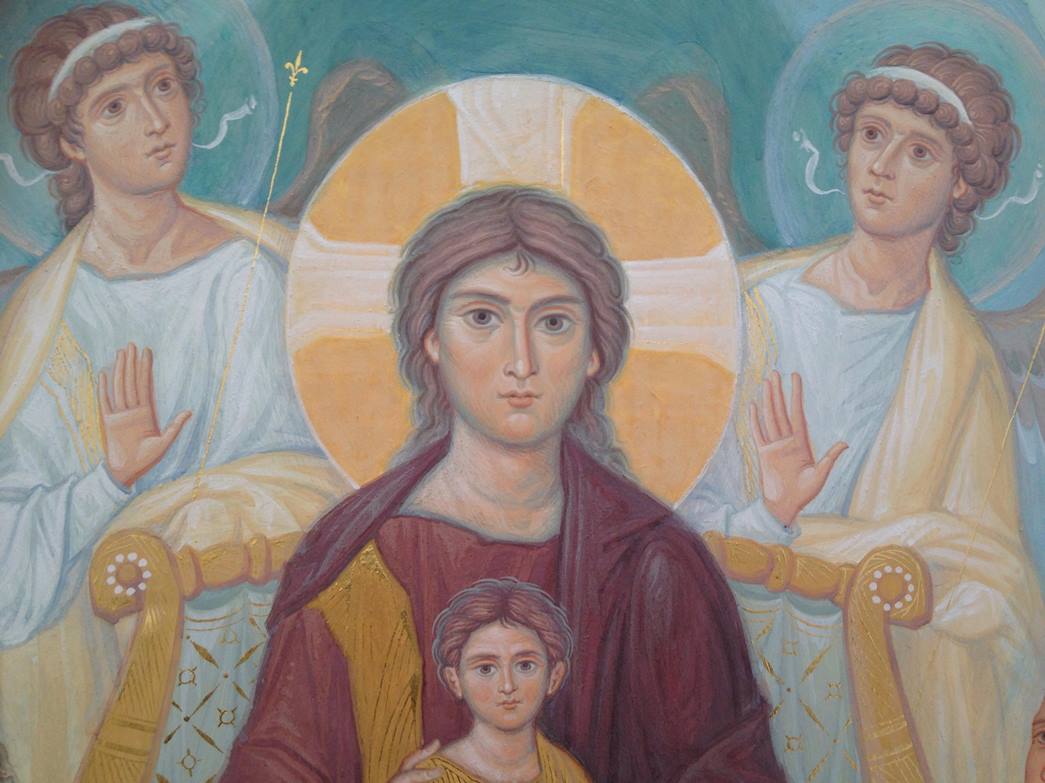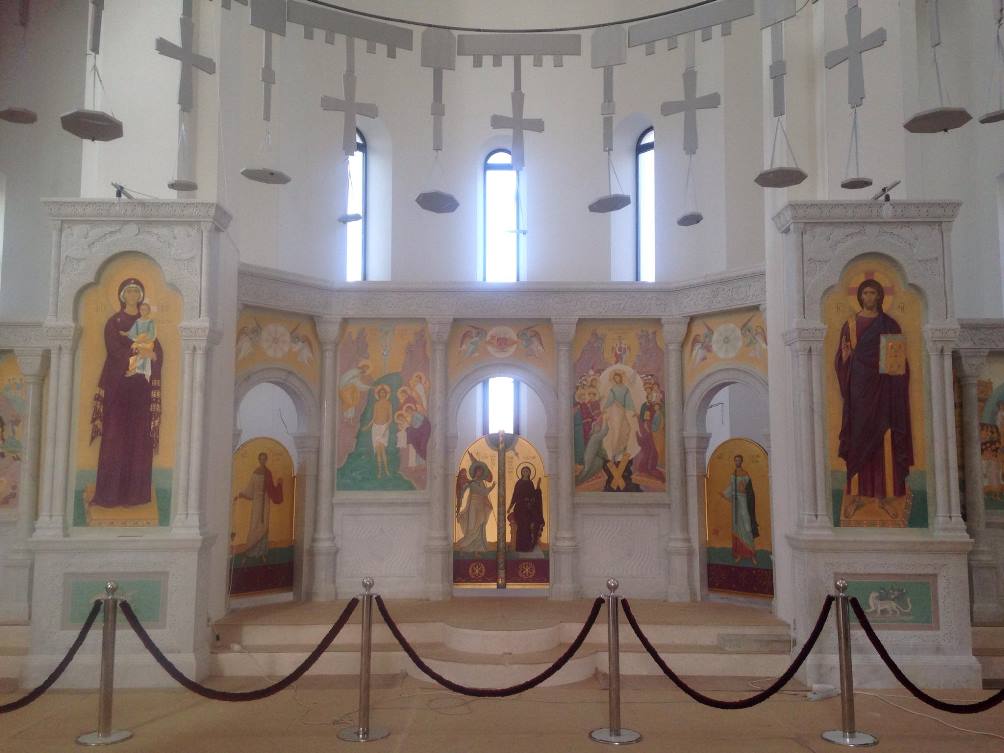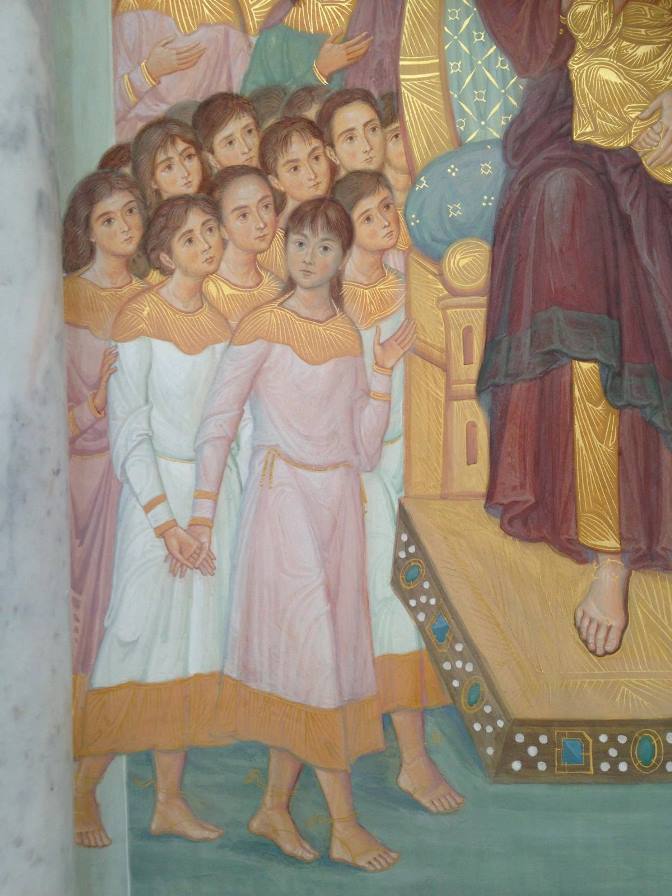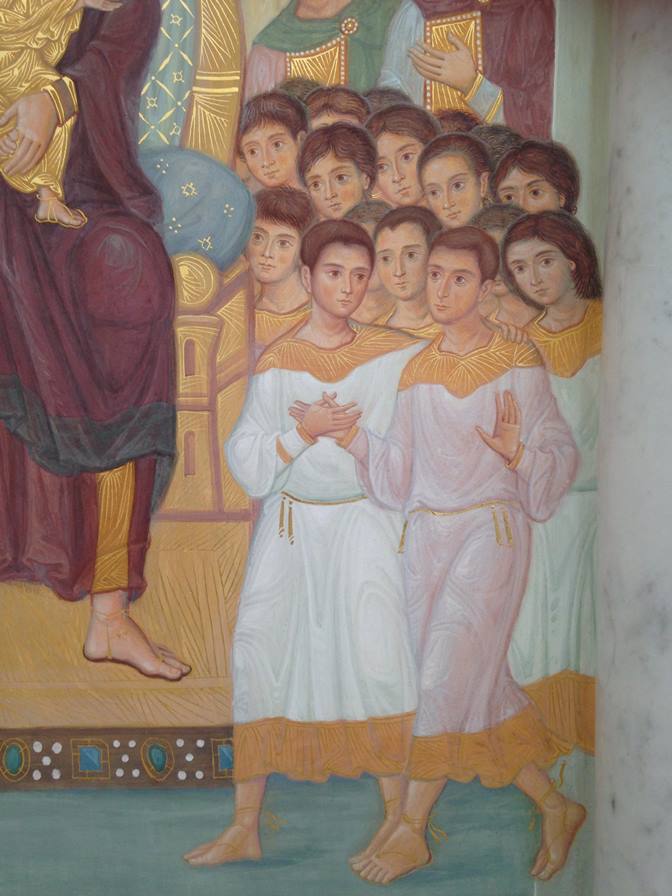Beslan Church, Russia - VM - Oksana Golovko
The Murals of the Church of the Resurrection in Beslan, Russia

A Token of Light and Hope
by Oksana Golovko
On September 1, 2004 parents with children dressed up and carrying flowers rushed to School Number One in the small town of Beslan in the Russian Republic of North Ossetia. The beginning of the schoolyear was a festive occasion. They did not know that they would be held hostage by terrorists in a bomb-infested school building. 333 people died, 186 of them children.
Later, at the general meeting of the citizens of Beslan, it was decided to place on that spot a church in honour of the Resurrection of Christ, as it is so important to tell about life at a place where so many children died. When you enter the church with its murals, you experience the joyful and light the atmosphere of the church.
The process of creating the murals was overseen by the Russian iconograher Alexander Soldatov. He says that when he first came to the church and began to think about the plan for the murals, he started with their aesthetic qualities. He thought about their colour scheme and chose, first of all, red, ochre, and a little malachite. In iconography ochre implies gold, which symbolizes divine light pouring on people and giving them hope. Red (purple) is the colour of royalty, while also symbolizing martyrdom. But most importantly it is the colour of Easter, of the Resurrection. There is so much pain on earth and the place where the church is located reminds us of that. Could we stand this pain if we didn't know that Christ had overcome death?

The murals of the iconostasis (mediating wall between nave and sanctuary) were made first. The image of Christ Pantocrator and the Virgin with the Child in full height are depicted in the foreground, as if they are moving towards the believers. They are here to share in the suffering of people, wiping away their tears. The red (with elements of ochre) robes of Christ are mirrored by the red robes of the Mother of God. If blue had been chosen as the colour of the Saviour's chiton, it would have destroyed the overall impression.

All of the victims are depicted: children and adults, in different scenes. In the Place of the Living section we can see the children, soldiers and teachers that were killed in the act. On the Saviour's lap one of the smallest of the children is depicted. Christ is shown here as Saviour Emmanuel – without a beard, at a young age, forever in Heaven. In this way he comes closer to those who are depicted around him. The children are holding hands, which makes the composition more unified both visually and meaningfully. The side parts of the Place of the Living show Bethlehem and the Heavenly Jerusalem, where the righteous reside with God and where is no sorrow and sin.
 |
 |
The images based on biblical stories are aimed at understanding the human tragedy in the context of Christian eschatology. Artist Samson Marzoyev remarks: “The composition as a whole represents the Kingdom of God, the triumph of life eternal and the mercy of God. In the Place of the Living the absence of the punishing sword in the hands of the cherubs and the star point to Christ as Victor over Hell and Death.”
After the first iconostasis paintings were finished, the question came up how the iconographic program should be developed further. It was decided to expand it gradually, through the input of many people. Alexander Soldatov states, “We thought for a long time whether to depict all the dead specifically and discussed it with those who are on the Board of Trustees of the construction of the church.” The general opinion was that it was important to portray everyone without exception. The members of Special Forces who died were given a place on the entrance pillars in the role of soldiers and guards. And all the children – not only Christians, but also Muslims whose parents gave consent – are included. The idea that everyone is equal in this death is important to Beslan.

Also Dzerassae Hosonova is part of the representation. In September 2001 she was eight when her mother brought her to the second grade. Dzerassae does not remember much of what happened next. She had serious head injuries, underwent several surgeries and spent six months in hospital. Dzerassae admits that when she sits on the church’s porch and looks at the school, instead of those terrible days she remembers only the good and happy things that happened before.
Actually everyone who comes to the church says that it makes them feel better. This is achieved by the murals, the light colours and the theological meaning, but most of all by the beauty of the church as it reflects divine Beauty. Beslan citizens say that the murals make them feel that the victims of the terrorist attack have remained alive with them. “They are with God now,” says Dzerassae.
*******
Church of the Resurrection of Christ, Beslan, Russian Republic of North Ossetia. The church was built in 2008-2019. It combines modern and traditional trends in Russian architecture.
Alexander Soldatov (b. 1965) is a Russian iconographer. He graduated from the Savitsky Penza Art College and the Iconography faculty of the Moscow Theological Academy. He is a professor at the Moscow Theological Academy.
Samson Marzoyev (b.1975) is a Russian iconographer. He graduated from the Art College of the city of Vladikavkaz, North Ossetia-Alania, Russia and the Iconography faculty of the Moscow Theological Academy.
The Beslan terrorist attack (also referred to as the Beslan school hostage crisis or the Beslan massacre) started on 1 September 2004, lasted three days, involved the imprisonment of more than 1,100 people as hostages (including 777 children) and ended with the deaths of 333 people, over half of them children. It was the deadliest school shooting in history. The crisis began when a group of armed Chechen terrorists occupied School Number One (SNO) in the town of Beslan, North Ossetia (an autonomous republic in the North Caucasus region of the Russian Federation). The hostage-takers were members of the Riyad-us Saliheen, sent by the Chechen warlord Shamil Basayev, who demanded Russian withdrawal from and recognition of the independence of Chechnya. On the third day of the standoff, Russian security forces stormed the building with tanks, incendiary rockets and other heavy weapons.
Oksana Golovko (b.1975) is a Russian art critic. She graduated from the department of the Theory and History of Fine Arts of the Surikov Moscow Art Institute. She is the author of numerous articles on art and the book Zhestylevo, devoted to the history of the Patron Church of the village of Zhestylevo, Moscow Oblast.
ArtWay Visual Meditation July 18, 2021


